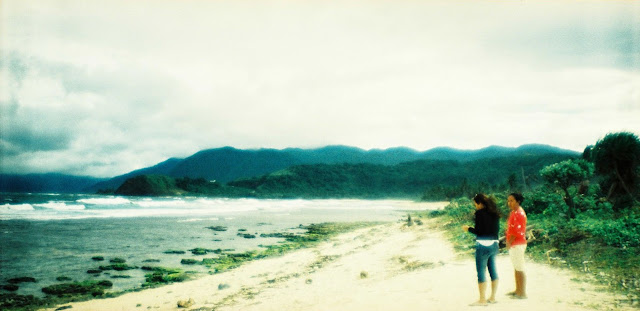4x4 and the La Paz Sand Dunes.
With our stomachs satisfied with breakfast and with our body recharged with just enough sleep, we set on a 4x4 ride to the sand dunes of La Paz. It was an instant wake-up call to our groggy selves.
We rode to the top of one of its sandy hills and had a misty view of this valley.
The place somewhat resembled scenes from the Lion King. Instead of animals grazing on its fields, it had a few 4x4 jeepneys riding up and down the sloping sand dunes. On one of its slopes, we tried out an amateur version of sand boarding: sitting on long boards while sliding down a 2-storey high sand dune.
Next on our itinerary was Cape Bojeador Lighthouse. It was built in late 1800's during the Spanish Era.
This lighthouse had 360 degree views of Ilocos Norte. One of them were cliffs overlooking seas adjacent to Ilocos.
Before we headed to our place, we went to Kapurpurawan Rock Formation. It was a walk in the middle of a marshland to reach the actual spot. To ease the burden of some tourists, horses were available to transport them to these immaculate white formations. We chose to reach it by foot.
Afternoon was spent resting at our lodging place. Before sunset, we headed to Pagudpud for a dip in the beach. It was a bit windy that afternoon but since the beach was a bit deserted, we were still able to enjoy the sand and waves.
Bangui Windmills was the first stop on our second day. These gigantic windmills stood on the shoreline of Bangui and they generated a big percentage of Ilocos Norte's electricity.
We then headed for a tedious and long trek to Kaangrian Falls. It was a bumpy jeep ride to reach the layover and it took us more than an hour trek inside the dense mountain. The final stretch was a climb downhill where we had to hold on to nearby plants and roots so we could safely reach the bottom. Our destination was worth it because of the crystal blue and cold water coming from the hush falls.
That morning trek drained our energy but before we took our late lunch, we stopped by Bantay Abot Cave.
It was not an actual cave which was typically found at the side or under a mound of land. It was, instead, a vertical formation with an interesting hole at its center. Its location was just along the roadside on our way to the Blue Lagoon.
Its hole provided views of waves crashing on rocky shorelines. The wind during that time was a bit harsh and chilly. We had to take refuge beside some rocks to protect us from its cold.
We had our late lunch at Casa Consuelo, Blue Lagoon. December weather was not kind enough to provide us a view of this supposedly calm beachfront.
Dos Hermanos Islands could be seen from Casa Consuelo. This protruding island in the photo was one of two similarly-shaped hills.
Our last stop for the day was Kabigan Falls.
It was another long walk but, this time, the surrounding areas were just fields and streams by the foot of a mountain. Kabigan Falls was tall and narrow, unlike the first one which was cascading and wide. There were other visitors in the area since reaching was much easier.
It was already dark when we safely reached our vehicle.
We left early next morning so we could start heading back south and could stop over some sites along the way.
We went over to the Malacanang of the North. This was the residence of former President Marcos during his regime.

It was a spacious mansion that was just beside Paoay lake.
Our next stop was the Church of San Agustin in Paoay. This baroque structure was considered a UNESCO heritage site. Like most old and well-preserved churches, this one was a famous wedding venue. During our visit, while one bride was having her post-wedding pictorial outside, another one was getting ready to walk down the aisle.
Before heading back to Ilocos Sur, we stopped by Marcos Mausoleum. This cold and eerie burial spot of President Marcos was filled with Gregorian chants to complete the mood.
Almost across the entrance to Vigan was the Bantay Bell Tower. This campanille was strategically placed above ascending steps beside its church. It was the focal point of its church complex. Up on its tower was a view of Vigan and surrounding areas, including a local cemetery.
Last stop before heading home was the city of Vigan. A walk along the cobbled street of Calle Crisologo transported us to a vintage setting of Spanish colonial residences and commercial areas. Like Paoay Church, this city was also granted an approval from UNESCO.


































No comments:
Post a Comment